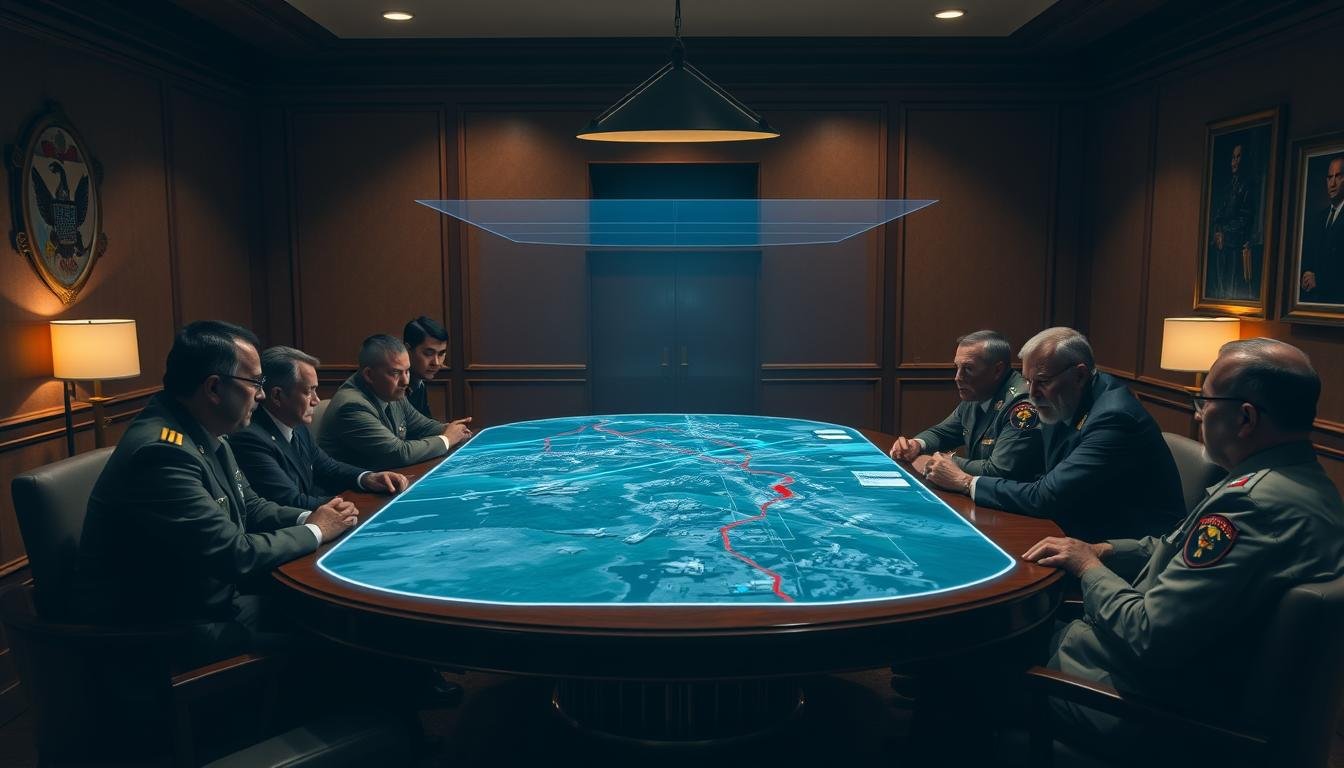5 Alarming Dangers of Using AI to Analyze Modern War
In the sanitized world of tech demonstrations and defense industry expos, the promise of artificial intelligence (AI) is presented as a panacea for the timeless complexities of warfare. We are told that with the right algorithms, we can finally cut through the “fog of war,” predict enemy movements with uncanny accuracy, and make strategic decisions…

In the sanitized world of tech demonstrations and defense industry expos, the promise of artificial intelligence (AI) is presented as a panacea for the timeless complexities of warfare. We are told that with the right algorithms, we can finally cut through the “fog of war,” predict enemy movements with uncanny accuracy, and make strategic decisions at machine speed. The allure is undeniable: to use AI to analyze modern war is to seek order in chaos, certainty in ambiguity, and victory through superior data.
This utopian vision, however, masks a far more perilous reality. As nations and non-state actors alike rush to integrate AI into their military intelligence and operational frameworks, they are stepping into a digital minefield of unprecedented scale. The very systems designed to provide clarity can, in fact, sow confusion, amplify bias, and lead to catastrophic miscalculations. The uncritical adoption of AI to analyze modern war is not just a technological upgrade; it is a paradigm shift fraught with alarming and potentially irreversible dangers.
This comprehensive analysis moves beyond the hype to dissect the five most critical dangers inherent in relying on AI to analyze modern war. We will explore how flawed data can poison algorithms, how coded biases can lead to discriminatory outcomes, how over-reliance can erode essential human skills, and how the ethical implications could reshape not only the battlefield but society itself. Through a detailed case study of the ongoing conflict in Ukraine, we will see how these are not theoretical risks, but active, unfolding threats.
The Shifting Landscape: Why We Turn to AI to Analyze Modern War
Before delving into the dangers, it is crucial to understand why the siren song of AI is so potent for military planners. The character of modern war has transformed, creating a strategic environment that overwhelms traditional methods of intelligence gathering and analysis.
The first driver is the data deluge. A modern war zone is an unprecedented generator of information. Data flows from a vast array of sources: high-resolution satellite imagery updated hourly, signals intelligence (SIGINT) intercepting communications, thermal sensors on drones, open-source intelligence (OSINT) from social media platforms like Telegram and X (formerly Twitter), and countless Internet of Things (IoT) devices. This torrent of data is measured in petabytes, far exceeding the capacity of human analysts to process, correlate, and analyze in a timely manner. The sheer volume necessitates a tool like AI that can sift through this digital noise to find the signal.
This has led to a fundamental shift from human-only analysis to a new model of human-AI collaboration. The goal is to let the AI handle the heavy lifting of data processing and pattern recognition, freeing up the human analyst to focus on higher-level tasks: contextual interpretation, strategic thinking, and final decision-making. In theory, this synergy should make the entire analytical process faster and more accurate. However, it is within this very human-AI interface that the most profound dangers begin to emerge. The machine is not a neutral partner; it is an active participant with its own inherent flaws and limitations. It is these flaws that we must now analyze.
The 5 Dangers of AI in Modern War Analysis

Danger #1: The “Garbage In, Gospel Out” Catastrophe
The oldest axiom in computing is “garbage in, garbage out.” In the context of using AI to analyze modern war, this principle takes on a life-or-death significance. The danger is not merely that bad data produces bad results, but that the AI can present these flawed results with a veneer of mathematical certainty, transforming “garbage in” to “gospel out.”
- Data Scarcity and Fragmentation in a Hostile Environment: A modern war zone is fundamentally an environment of data denial. An adversary will actively work to destroy sensors, jam communications, and employ camouflage and concealment. The result is an intelligence picture riddled with holes. An AI tasked to analyze logistics might try to predict a unit’s combat readiness but lack data on its actual fuel and ammunition levels. The algorithm will still produce an answer, perhaps by extrapolating from incomplete data, but this answer will be a statistical guess presented as a confident assessment. A commander acting on this “confident” assessment could send their forces into a trap, believing the enemy is weaker than they are. The AI cannot analyze data that isn’t there, but it can create a dangerous illusion that it has.
- The Poison of Active Deception and Misinformation: More insidious than missing data is deliberately false data. A modern war is fought as much in the information space as on the physical battlefield. State-sponsored troll farms, botnets, and sophisticated deepfake technologies are used to flood the zone with propaganda and manipulate perceptions. An AI designed for OSINT, for example, might be tasked to analyze social media to gauge civilian morale or track troop movements. It could easily be duped by a coordinated campaign showing fake videos of surrendering soldiers or staged protests, leading it to conclude that an enemy’s will to fight is collapsing when the opposite is true. The AI excels at identifying patterns, but it struggles to discern the intent behind those patterns, making it a vulnerable target for psychological operations.
- The Echo Chamber Effect: An AI system’s performance is a reflection of its training data. If an AI is primarily trained on news reports and intelligence briefings from a single nation or alliance, it will adopt the inherent biases and narratives of those sources. When tasked to analyze a new conflict, it will interpret events through this pre-existing lens, creating a powerful analytical echo chamber. It will find evidence that confirms its baked-in assumptions and dismiss data that contradicts them, reinforcing a single point of view and blinding decision-makers to alternative interpretations of the modern war.
Danger #2: Algorithmic Bias – The Digital Ghost in the Machine
Perhaps the most subtle and alarming danger is that of algorithmic bias. An AI is not an objective, all-seeing eye. It is a complex mathematical system built by humans and trained on human-generated data, and it inherits all of our conscious and unconscious biases. When used to analyze modern war, this bias can have lethal consequences.
- Biased Training Data and Historical Baggage: If an AI is trained to identify “insurgent behavior” using historical data from a specific conflict, like the Iraq War, it will learn a set of patterns associated with that specific time, place, and culture. When this same AI is deployed to analyze a different modern war in a different part of the world, it will search for those same patterns. It might incorrectly flag a peaceful gathering as a prelude to an attack or misinterpret a local custom as hostile activity, simply because its historical training data has taught it a biased and narrow definition of “threat.” The AI is not truly learning to analyze modern war; it is learning to find echoes of past wars.
- The Encoded Worldview of the Developer: Every line of code and every architectural choice in an AI reflects the worldview of its creators. An AI built by a defense contractor in the United States will likely be designed around Western military principles of centralized command and overwhelming force. When tasked to analyze an adversary that employs decentralized, asymmetric, or hybrid warfare tactics, the AI may fail to understand their strategy. It might interpret their actions as chaotic or irrational, completely missing the underlying logic of their campaign. This is a form of cultural and strategic bias encoded directly into the system, preventing it from being able to accurately analyze the full spectrum of modern war.
- Proxy Discrimination and its Lethal Consequences: An AI might not be explicitly told to discriminate against a certain ethnicity or religious group. However, it can learn to do so through proxies. For example, if it analyzes data and learns that a specific dialect, geographic location, or pattern of social media activity is correlated with “enemy combatant” in its training data, it will begin to use that proxy variable for targeting. The AI will then flag individuals based on these proxies, effectively creating a system of automated discrimination. This launders human prejudice through a layer of algorithmic complexity, making it appear objective and data-driven when it is anything but.
Danger #3: The Peril of Automation Bias and Human Deskilling
The integration of AI into military analysis creates a powerful psychological trap for its human users: automation bias. This is the well-documented tendency for people to over-trust and over-rely on the output of an automated system, often ignoring their own intuition and contradictory evidence. In the context of modern war, this is a recipe for disaster.
- Erosion of Critical Judgment and the “Check-the-Box” Mentality: When an AI consistently provides fast and seemingly accurate answers, human analysts can become complacent. They may stop performing their own due diligence, cross-referencing sources, or questioning underlying assumptions. Their job shifts from deep analysis to simply validating the machine’s output. The rigorous, skeptical mindset that is the hallmark of a good intelligence officer begins to atrophy. The process of how to critically analyze modern war is replaced by a process of simply managing the AI‘s workflow.
- The Speed Trap: Decision-Making at an Inhuman Pace: A modern war moves quickly, and there is immense pressure on commanders to accelerate the “kill chain”—the process from identifying a target to eliminating it. AI promises to shorten this cycle dramatically. However, this forces human decision-makers to operate at machine speed. A commander might be presented with an AI-generated target list and given only seconds to approve a strike. In that timeframe, there is no opportunity for moral deliberation, contextual assessment, or a “gut check.” The human becomes a mere rubber stamp in an automated process, abdicating their moral and cognitive responsibility.
- The Loss of the “Art” of Intelligence: For centuries, intelligence analysis has been considered both a science and an art. The “art” is the human element: the intuitive leap, the understanding of human psychology, the ability to read between the lines of a report to understand an adversary’s fears, ambitions, and deceptions. An AI cannot replicate this. It can analyze data, but it cannot understand human nature. By offloading cognitive tasks to the machine, we risk deskilling an entire generation of analysts and commanders, leaving them utterly dependent on their AI crutch and unable to effectively analyze modern war without it.
Danger #4: The Algorithmic “Fog of War” – Compounding Uncertainty
The classic concept of the “fog of war,” coined by Prussian general Carl von Clausewitz, describes the inherent uncertainty, confusion, and chaos of the battlefield. Proponents of AI claim it can finally lift this fog. The more alarming reality is that AI may actually create a new, more dangerous type of fog: a digital illusion of clarity.
- The Inability to Model True Chaos: AI, particularly machine learning, excels at finding patterns in data and making predictions based on those patterns. It operates on the assumption that the future will, in some way, resemble the past. However, a modern war is a profoundly chaotic, non-linear system. It is defined by surprise, deception, and events that break all historical precedents. An AI trained on predictable models will be brittle and fragile when faced with true chaos. Its predictive models can fail spectacularly, leaving commanders who trusted them completely blindsided.
- The “Black Swan” Problem and Failure to Recognize Novelty: Related to the chaos problem is the inability of AI to handle true novelty. An AI system can only analyze what it has been trained to recognize. It is exceptionally poor at identifying and reacting to “black swan” events—unforeseeable occurrences with massive consequences. A novel enemy tactic, a new type of weapon, or an unexpected political development will not fit into any of the AI‘s pre-existing categories. Instead of flagging it as a critical unknown, the AI may ignore it or misclassify it, robbing decision-makers of the crucial early warning they need to adapt to a changing modern war.
- False Confidence and the Danger of Misleading Metrics: One of the most dangerous features of many AI systems is that they provide a “confidence score” along with their analysis. An AI might report that it is “95% confident” that a building contains an enemy command post. This number, however, is not a true measure of real-world probability. It is a statistical artifact of the model’s internal calculations. To a human decision-maker under stress, a “95% confidence” score sounds like a near certainty. They may not understand that this confidence is based on incomplete and potentially biased data, leading them to authorize a strike with a false sense of assurance. The AI’s confidence can be dangerously contagious.
Danger #5: The Pandora’s Box of Ethics and Dual-Use Technology

Beyond the technical and operational dangers lies a profound ethical minefield. The technologies we develop to analyze modern war will not remain confined to the battlefield. They will inevitably bleed into civilian life, posing long-term threats to privacy, civil liberties, and the very nature of human society.
- The Surveillance State as a Byproduct of War: To effectively analyze modern war, an AI must be designed for mass surveillance. It needs to ingest data from every available sensor, monitor communications, and track the movements of individuals. While this may be justified under the laws of armed conflict, the infrastructure of surveillance built for wartime does not simply disappear when peace is declared. These powerful tools can be repurposed by governments for domestic law enforcement or social control, creating a surveillance state that was built on the back of military necessity.
- The Dual-Use Dilemma and Proliferation: An AI system designed by a major power to analyze satellite imagery for military targets can be sold to other countries. In the hands of an authoritarian regime, this same technology can be used to monitor ethnic minorities, track political dissidents, or plan internal crackdowns. The very features that make the AI effective for a modern war—its ability to identify patterns and anomalies in human behavior—also make it a perfect tool for oppression. Responsible innovation becomes nearly impossible when the core technology is inherently dual-use.
- Lowering the Threshold for Conflict: A significant ethical concern is that by making war seem more “scientific” and “data-driven,” AI could actually make the decision to go to war easier. If leaders are presented with AI-generated analyses that promise a quick, low-cost, and decisive victory, they may be more inclined to resort to military force rather than pursuing diplomacy. The illusion of a clean, technologically managed modern war could lower the political and psychological barriers to initiating one, with devastating consequences for global stability.
Case Study: The Ukraine-Russia War – AI’s Dangers on Full Display
The ongoing conflict between Russia and Ukraine serves as the world’s most vivid and harrowing real-time laboratory for the use of AI to analyze modern war. It has showcased the technology’s potential while simultaneously bringing all five of the aforementioned dangers into sharp, undeniable focus.
The Data War (Danger #1): The information landscape of the Ukraine war is arguably the most contested in history. Both sides have weaponized information on an unprecedented scale. OSINT aggregators using AI to analyze social media have been flooded with staged videos, manipulated satellite photos, and conflicting reports. For example, an AI attempting to analyze Russian equipment losses based on geolocated images must contend with the fact that Ukraine has an active interest in inflating these numbers, while Russia seeks to minimize them. The raw data is so polluted with propaganda that any purely algorithmic analysis is inherently suspect.
Conflicting Biases (Danger #2): Western companies and governments providing AI tools to Ukraine have trained their systems on NATO military structures and data. When these tools try to analyze the more rigid, top-down command structure of the Russian military, they can make critical errors. An AI might interpret the lack of initiative among Russian junior officers as a sign of imminent collapse, failing to understand that this is a feature, not a bug, of their military doctrine. The AI is applying a biased lens, preventing a clear analysis of this modern war’s unique dynamics.
Automation in the Kill Chain (Danger #3): Reports have emerged of both sides using custom-built AI targeting systems to accelerate their artillery and drone strikes. While this increases efficiency, it also places immense pressure on human operators. A drone pilot guided by an AI that highlights a potential target has mere moments to verify the information and make a life-or-death decision. The temptation to trust the machine—to succumb to automation bias—is immense, increasing the risk of tragic mistakes and civilian casualties.
The Fog of Electronic Warfare (Danger #4): Russia has engaged in widespread and sophisticated electronic warfare (EW), jamming GPS signals, drone communications, and other sensors. This creates a digital fog that directly attacks the data streams feeding AI systems. An AI that relies on a steady flow of GPS data to analyze troop movements will be rendered useless or, worse, will produce wildly inaccurate results when that data is disrupted. This demonstrates how a modern war environment can actively target and exploit the very foundations of an AI system’s analytical capability.
The Ethical Precedent (Danger #5): The widespread use of commercial facial recognition AI to identify Russian soldiers (both living and deceased) and contact their families sets a chilling precedent. While used by Ukraine for psychological leverage in this modern war, the same technology could be used by any state to create databases of its own citizens or the citizens of other nations, creating a tool of mass surveillance with global reach. The ethical safeguards have been outpaced by the wartime application.
As this video analysis explores, the war has become a proving ground where these theoretical risks have manifested as battlefield realities:
Let’s analyze how each danger has played out in this specific modern war:
Conclusion: A Mandate for Human-Centered AI in Warfare
The drive to use AI to analyze modern war is irreversible. The potential advantages in processing speed and data volume are too significant for any modern military to ignore. However, blind adoption is a path to ruin. The five dangers we have analyzed—flawed data, algorithmic bias, human deskilling, the illusion of clarity, and the ethical fallout—are not minor glitches to be patched later. They are fundamental, structural risks inherent in applying a deterministic technology to the chaotic, human-centric domain of warfare.
The only responsible path forward is to reframe the goal. We must move away from the pursuit of a fully autonomous AI that can analyze modern war on our behalf, and instead focus on creating human-centered AI. This means designing systems that are transparent, interpretable, and built to augment, not replace, human judgment.
This requires a new set of principles for military AI development:
- Radical Transparency: Human operators must understand why an AI has reached a certain conclusion. “Black box” algorithms, whose decision-making processes are opaque, are unacceptable in high-stakes environments.
- Continuous Human Oversight: A human must be “in the loop” or “on the loop” for all critical decisions, especially those involving lethal force. The machine can recommend, but the human must decide.
- Adversarial Testing: AI systems must be rigorously tested against red teams that actively try to deceive and manipulate them with bad data and novel tactics.
- Ethical Guardrails by Design: Ethical considerations cannot be an afterthought. They must be built into the core architecture of the AI, with clear rules to prevent misuse and limit unintended consequences.
Ultimately, we must remember that a modern war is not a data problem to be solved. It is a profoundly human tragedy. To analyze modern war requires not just the processing of information, but the wisdom to understand its context, the empathy to grasp its human cost, and the moral courage to make difficult choices. An AI has none of these qualities. Our greatest danger is to forget that we do.
For a broader perspective, explore our complete collection of articles on AI and technology.


![Best Phone in 2025: Don't Buy Wrong! [Tested & Ranked] 5 best-phone-in-2025](https://newiafutures.com/wp-content/uploads/2025/07/best-phone-in-2025-768x580.png)




